The ability to tell time is one of the most important everyday skills that your baby will have to learn. The sooner he masters this, why hide, difficult science, the better for everyone. But how do you teach a child to tell time? How to explain to the kid in an accessible and understandable way what the seasons are and why the minute hand is needed?
Start over
For a child, time is something non-existent, amorphous, indefinite. Of course, the baby understands that life does not stand still, but it is not yet possible for him to characterize this movement.
Introduce him to the most basic concept of time, namely the future, present and past.
Give simple examples.
- Future: soon we will go to visit grandma.
- Present: Now we are eating a cake.
- Past: We built a birdhouse and hung it on a tree.
Explain to your child the difference between three actions performed at different times. Operate only with words that are understandable to the baby and actions that are interesting for him.
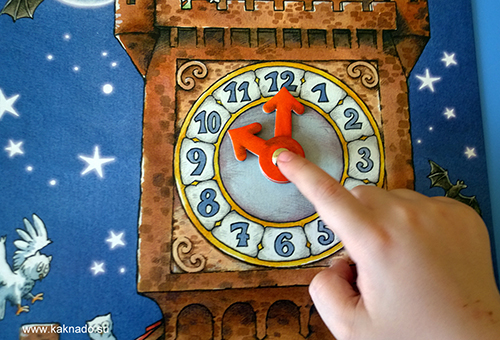
When to teach a child to tell time?
It is necessary to acquaint the child with the future, past, present, as well as with the seasons and time of day as early as possible. At 2.5-3 years old, children can already easily navigate in the concepts of “day - night”, “tomorrow - today”, “winter - summer”, as well as name twelve months and four seasons.
You can introduce a baby to a watch at the age of 4-5, the main thing is that by school he can freely determine the time by the clock.

How to teach a child to tell time?
When teaching a child to determine time, one should follow a certain sequence, namely, move from simple to more complex.
Conventionally, the whole process can be divided into three stages.
- Teaching the concept of "seasons".
- Learning the concept of "time of day".
- Learning the concept of hours and minutes.
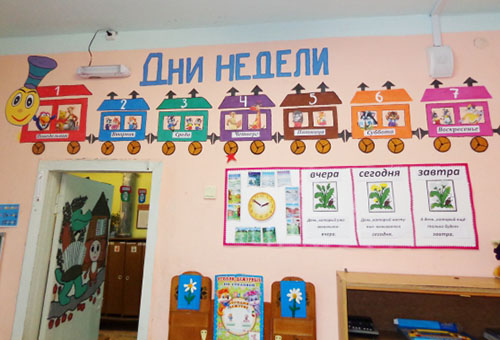
Introducing the baby to the calendar
This is the first step in introducing the child to the concept of time. First, tell your child about the 4 seasons: winter, spring, summer, autumn. For clarity, show nice pictures every time of the year. Also on sale there are special materials that help the child learn information faster: books, CDs, cartoons.
It would be useful to introduce the baby to the Soviet cartoon "Twelve Months".
Associations are very helpful. Describe each season and associate this description with the tactile and emotional sensations of the crumbs.
- Winter - snow, cold, New Year, Santa Claus, snowman, warm clothes.
- Spring - melting snow, streams, boats, the first foliage.
- Summer - heat, sun, river, sea, ice cream, berries and fruits, cottage, village.
- Autumn - cold, wind, rain, gray sky, mushrooms, puddles, bright leaves.
Show your child as the season progresses. distinctive features: first grass, sticky snow, acorns and dry leaves.
The next step is to buy a calendar. He will visually teach the child to navigate the annual cycle. It is better to choose a simple calendar with large numbers and letters. The entire year must be represented on one sheet.
But what calendars should not be bought:
- with foreign inscriptions;
- detachable;
- with abbreviations (days of the week, months);
- with moving flag.
Hang the calendar in a prominent place and every day tell your baby what month, day of the week, date is. The past date can be crossed out or painted over with a felt-tip pen.
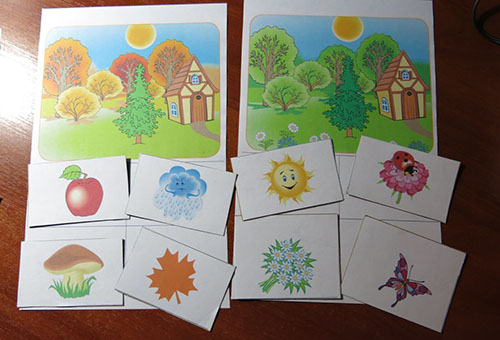
Make your own play set.
- Print or cut out four colorful illustrations representing the seasons.
- Take 4 envelopes and paste pictures on them. Make signatures - "Winter", "Spring", "Summer", "Autumn").
- Find 12 bright pictures for each of the 12 months. Make cards with signatures (January, February, etc.)
As you may have guessed, this game is simple, but very useful. Invite your child to put in each envelope those months that relate to the season indicated on the envelope. Praise your child for a job well done.

Now introduce the child to the time of day. It is not difficult to do this, since the kids themselves feel and see the change of day to night, night to morning, etc.
You can offer the baby useful games.
- Draw or cut from magazines miscellaneous items: comb, pillow, toothbrush, lamp, etc. Ask your child what time of day he uses this or that object. Praise the baby for each correct answer, and award a small prize for 10-20 “hits”.
- Have the child make short story about what he does in the morning/afternoon/evening. You can ask questions yourself: when do you brush your teeth? When do we go for a walk? When does dad come home?
These games will prepare the kid for learning to navigate by the clock, because the time of day is directly related to the clock face and hands.
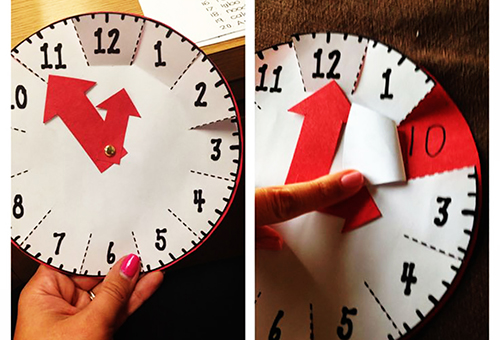
Now that the baby knows the concepts of "year", "month", "week", "day", you can introduce him to the concepts of "hour", "minute", "second".
- First of all, buy a watch with a large dial, 12 numbers and thick, large hands. Everything should be clear and bright. In the bookstore, you can choose a special set for teaching the child to tell the time by the clock. These sets include cardboard clocks.
- Introduce your child to arrows. The second hand for ease of learning and perception can be ignored for now.
- Tell me which way the hands on the clock go.
- Explain to your child that 1 day = 24 hours. That is, small hour hand should go around the whole dial twice.
- Explain that an hour is when the minute hand is at 12 and the hour hand is at any other number. The number indicated by the hour hand is the "exact time".
Now you can explain why you need a minute hand.
Of course, learning will be easier if the child can count up to 60 and knows how to multiply by 5. In this case, you can first tell the baby that 1 hour is equal to 60 minutes.
- Move the minute hand from 12 to 1. Say that 5 minutes have passed.
- Move the hand further by 2. 10 minutes have passed. (2 times 5 is 10)
When the child understands what in question offer him a workout. Move the arrow, for example, to 8. Ask your child: “What time is it?”
If the child knows the multiplication table for 5, he will multiply 8 by 5 and get the answer. If he is not yet familiar with the multiplication table, invite him to count: 5, 10, 15, 20, etc.
Do not introduce the concepts of “five to five”, “to a quarter”, “half” until the child learns to quickly and easily tell the time by the clock.

Clock Games
To consolidate success, and at the same time check how much the child understood the information you presented, invite him to play simple games with clock.
- Remove the clock from the wall or take a cardboard analogue with moving hands. Set any time. For example, 9:20. Have your child tell you what time it is. Move the arrows until the baby becomes more confident in saying the time, but do not overdo it and do not tire the child.
- There is a reverse version of the above game. Ask your child to set the clock to the time you name.
- Take two clock faces and set them to different times (for example, 2:30 and 20:20). Ask the child what he usually does at this time (sleep, wash, have breakfast, etc.).
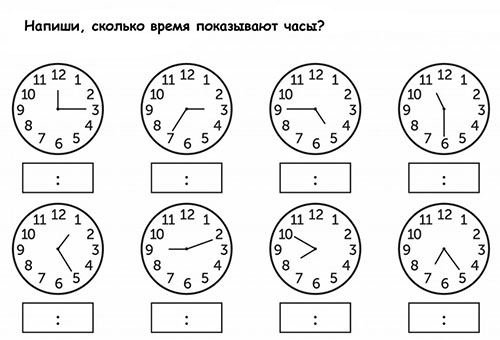
Didactic material
There are many pictures and tasks on the Internet that will help your baby learn to tell the time by the clock. Download and print (preferably in color) these tasks and offer the baby.
There is also specialized literature. The following list is recommended reading.
- "Conversations about space and time", T. Shorygina.
- "Smart watch. Learning to understand time”, N. Naydenova.
- "Measures of time, length, mass, cost", G. Shalaeva.
- "Learning to tell the time (book with stickers)", N. Morgan.
- "Clock and time", G. Chernenko.
Conclusion
Children love to learn and are drawn to knowledge. Every kid wants to comprehend the mysterious "science" of determining the time. Do not push the child away, but clearly explain to him everything that interests him. Use colorful materials - toys, cards, books, coloring books. Show your child a movie about time and clocks. The more information you provide your child, the better his exploratory instinct will be satisfied.
The world around for a child is an exciting fairy tale full of adventures, magic and surprises. He quickly masters it, learns to understand the basic laws and rules. Parents pay more attention to such intellectual skills of the baby as logical thinking, development of speech, learning to write or read. But it is also very important to teach the child to navigate in time, to understand what hours, minutes, days are. For this, training watches that you can buy on our website are perfect.
When should you buy a training watch?
What a watch is, a child already knows confidently at 1-2 years old. But for now, for him, it's just a round plate with arrows on the wall, which ticks merrily. He recognizes the alarm clock in the picture in the book, he likes to play, putting a shiny watch on his father's hand. But the child still does not know how to navigate by the clock. When is it worth buying a learning watch for a baby and how to teach him to tell the time correctly?There is no one universal method for all children. Many kids already at 1-1.5 years intuitively understand the sequence of events (in the morning we get up and go to the kindergarten, and it will be possible to play in the afternoon; dad comes in the evening when the sun has already set). But what is an hour or a minute, the children do not know. They do not associate certain events in their lives with a specific time. Educational watches for them can become just another beautiful, but incomprehensible toy.
How time sees Small child: "When my mother and I were walking in the park, I saw a dove", "I was upset when Sasha went home before everyone else." You need to start acquaintance with the training clock when the baby already understands and uses other temporary categories:
- "before" and "after" (I get up, my mother prepares breakfast, and then we go to the kindergarten, after sleep my father picks me up, after bathing I watch a cartoon);
- morning, evening, day, night;
- days of the week, seasons.
Educational hours for the little ones: how to work with toddlers
The easiest way for a child to perceive time is if he has a certain daily routine. You can use the learning clock for toddlers as a game. First, study the dial, find all the familiar numbers. Ask the child to run their finger from 1 to 12, calling them in order. Ask where the arrow will run. The direction of movement of the arrow is not easy to remember, but after that things will go smoothly.Play with the learning clock using only one, smaller hand. Let the child simply remember where the numbers are placed and learn to call them (the hand at 3 is three o'clock, afternoon tea time!).
The next task is to help the child understand the passage of time. Put the hand at eight o'clock. It's morning. Now our baby will wake up. He should be in the garden in an hour. When it will be? How to show that one hour has passed? Turn the training clock hand one step. And in three hours there will be lunch, exactly at 12. How to run the arrow for three hours?
You can work with minute hands as early as 4-5 years old, if the child knows the numbers well and understands how time goes by, how many hours are in one day, why twelve is both midnight and noon. Training hours will be a great helper for you in this difficult task.
In our online store you can buy educational watches for the little ones, board games with clocks, calendars of nature, materials for studying the days of the week. The range of goods is very large, everyone can choose useful benefits for their baby here.
Keep track of every day, count every minute spent! Time is the only place where stinginess is commendable.”
T. Mann
Your quite recently unintelligent peanut already knows how to count? He wonders why the night comes and where did the day go? Then it's time to use the potential of the brain that has not yet been loaded and learn how to navigate by the clock face. In the future, you can be sure that a small student will understand the value of time and will be able to use it rationally. And we, in turn, will tell you how to teach your child to tell time by the clock with maximum efficiency.
Elena, mother of 8-year-old Igor: “For the first six months, my grandmother collected her son for school, because I am a doctor and work in shifts. Now, due to circumstances, he is forced to assemble on his own, with my control over the phone. He can easily navigate by the clock when I say that you need to leave the house in 15 minutes. I've only been late in a month."
Basic Principles of Teaching Time
In order for a child to be able to understand time using mechanical and electronic watches, you will have to learn to count up to one hundred. Some kids can count to 100 by age 5, while others can count by age 7. This is all considered normal. However, without this skill, understanding the mechanism of time movement is impossible.
The main skills of the child in the development of time should be:
- Ability to count from 1 to 100 (or at least up to 60);
- Visual recognition of each number from 1 to 12;
- Ability to write these numbers;
- Counting skills through 5 (5, 10, 15, 20, 25, 30).
If your child already knows, understands and can do all this, you can begin to study the concept of time.
How to explain to a child what time is
What is the time on the clock for children? A certain figure that adults call, looking at the clock. And if there is no clock in the house and adults use telephones instead, then the abstract concept of time is not at all clear to the child.
In the process of teaching a child the definition of time, it is important to help him master this concept and feel its length or intervals using specific examples.
- So, start with simple claps, each of which is equal to one second. Clap with your child to the beat of a clock that has a second hand. At the same time, explain that now you are clapping your hands in time with the time.
- Later, start paying your child's attention to the duration of his game or watching a cartoon. For example, one episode of your favorite animated series lasts 20 minutes. Voice it. Or time your child's time to get dressed.
- Next, you need to explain to the child that our day is a day in which there are 24 hours. 12 of them he rests and sleeps. The remaining 12 hours are given to do all the important things - breakfast, lunch and dinner, games with friends in kindergarten or preparation for school and so on. And each of these activities requires a certain amount of time.
Such simple exercises will help the child navigate the time periods and understand that each action requires a certain amount of time.
We make watches and learn to be friends with them
The child knows that the clock determines the time, but does not know how they work. Therefore, when studying time, it is important to have a watch with a dial on hand.
If you want to quickly teach your child the time by the clock, we recommend that you make a homemade clock face, which will become your training device and a bright visual aid for a start.
So, from a piece of thick cardboard we cut out a circle with a diameter of 25-30 cm. We apply markings in the form of a dial and in the center, using a small bolt and nut, we fasten cardboard hands - minute and hour. For vivid clarity, you can paint them in different colors and even sign them. Do not forget about the size of the arrows. Minute - longer, hour - shorter.
- Show how the hands move, introduce the child to the minute hand and tell them that it always moves the hour hand forward. That is, the minute hand is more important, because it is larger. It is these associations that will help the child understand that when the minute hand is set to the largest number 12, it means that an hour has passed.
- Explain that the arrows move only from left to right in a circle, this is called "clockwise movement". Set both arrows to 12 and show how they move.
An exercise
Practice moving the arrows. Set the game dial to different whole hour values, and ask the child to name the numbers they stopped at.
After the concept of time and the basic principles of the clock have become clear, it's time to learn to understand the time by the clock.
How to teach a child to tell the time by the clock
The main aspect that should be emphasized when studying a mechanical or electronic watch is the trajectory of the movement of time.
It is necessary to explain to the child that time is the only value that cannot be returned back. It constantly goes only forward and its course and distance can be measured only with the help of a watch. The clock in this case acts as a measuring instrument.
Now you need to explain to the child what an hour, minute, second is.


An exercise:
- Watch the movement of the second hand on the dial and the offset of the minute after the second makes a complete revolution.
- Record the time. Show your child the clock face, on which the minute hand will occupy a certain position, and then invite him to do something for the next couple of minutes. Then again draw the child's attention to the position of the minute hand on the dial. Note exactly how much time he spent on his lesson.
It is time to learn to recognize the whole hour, its half and a quarter.
- Now we study the concept of half an hour. Here it is important to remind the child that there are 60 minutes in an hour. And if half an hour passes, then, accordingly, 30 minutes pass.
- After the child has mastered the meanings of "a whole hour" and "half an hour", it's time to move on to learning a quarter of an hour. That is, explain to the child that the minute hand can also show 15 minutes of the passed hour. The principle of learning is the same as with a whole or half time value.
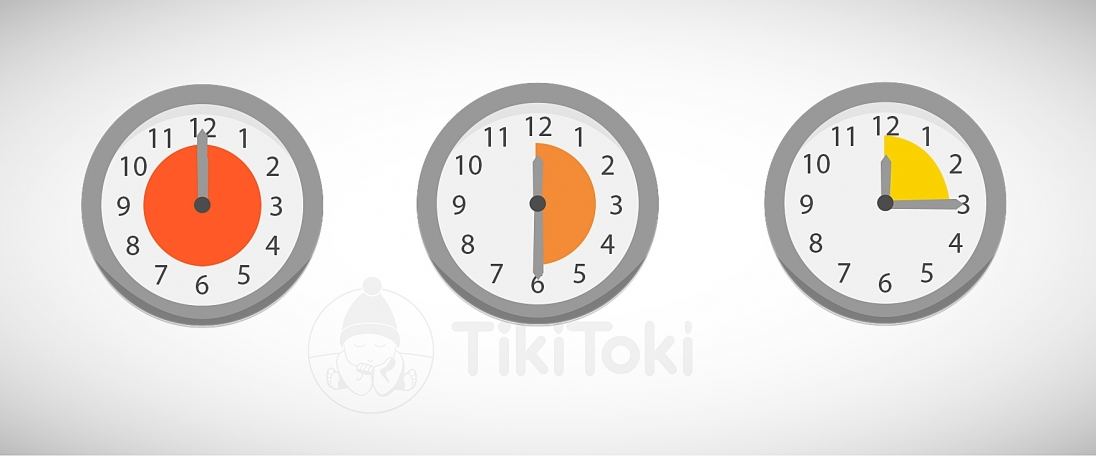
Exercises
Using the minute "main" hand on the cardboard clock, we show the value of half an hour. We set the minute hand to the desired value (number 6), slowly moving it around the circle of the dial to the number 12. Let the child understand that this is how half an hour passes. Practice with different clock positions.
Fix the result on a real watch. Ask your child to tell you what time it is, guessing so that the minute hand is on the number 6.
Inna, Polina's mother, 6 years old: “I always focused my daughter's attention on waking up and going to bed, using the wall clock in the nursery. Every time she went to bed, she saw on the clock 9 o'clock in the evening, and waking up - 7 o'clock in the morning. So, already at the age of 5, Polina perfectly mastered the concept of “a whole hour” and the meaning of the minute hand on the dial.
How to teach your child time by the clock in 5 minute increments
And only after mastering simple skills, you can move on to more complex ones, and explain to the baby that the minute hand can count time in increments of 5 minutes. Here it is important to teach the child to count in 5 and show him the passage of time using the game dial as an example.
You can put the numbers corresponding to the minutes opposite each value on the cardboard dial. For example, opposite 1 we write 5, opposite 2 - 10, etc. Moreover, it is important to first master the movement of the minute hand on the first half of the dial, and only after that complicate the task with the transition to a more complex second part.
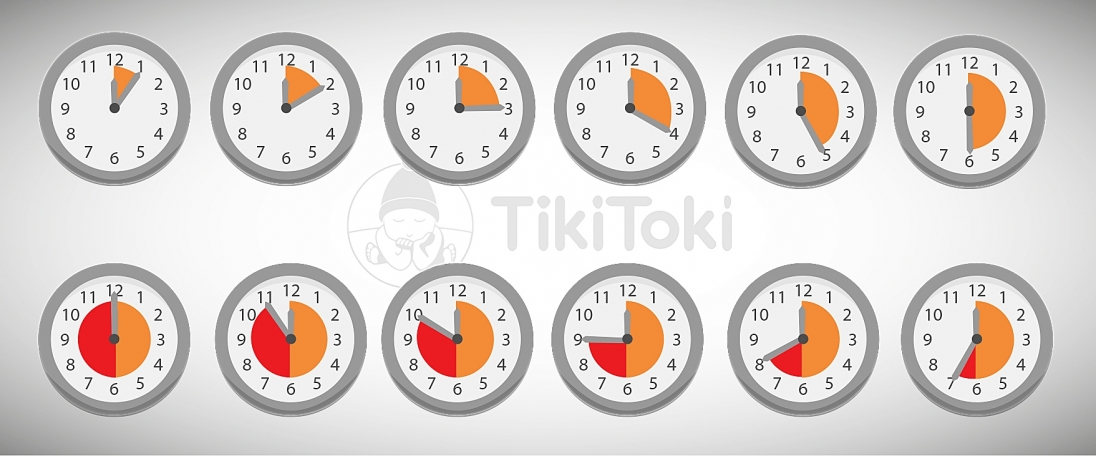
An exercise
We fix the result with a real watch. During the day, ask the child to look at the clock during the day.
In addition to such activities, it is very convenient to make a schedule in pictures with the corresponding images. The child will understand that a certain time is due to a certain action and thus will be able to learn to plan his day in accordance with the hour period allotted to him.
Irina, mother of a first-grader: “Together with my son, we drew 3 dials on a sheet with different times. On the first it was 8:00 and the inscription - it's time to go to school. On the second 16:00 - lessons, and on the third 22:00 - sleep. They hung it in a prominent place in the nursery. The son, glancing at his watch, determined the time himself. Knowing it was time for bed was no surprise to him, and I didn't have to rush him to school. I have become more calm, my son is more organized and independent.”
Online game "Learn the time on the clock"
Along with simple learning on the game dial, you can also use a special electronic training program.
The game is intended for children of primary and secondary school age.
The user-friendly interface of the program and bright cheerful dials will allow your baby to quickly master the skills of orienting in time.
Good luck with your studies and good mood.
Useful video
Game "Clock"
Game "Clock" for children is aimed at concentrating the child's attention on the game clock for as long as possible and thus facilitating parental work. After all, to teach a baby to navigate the clock correctly, in fact, for parents is a whole art. Moms and dads have to devote enough of their time to explain the same designation ten times.
Game clock online- an excellent training of memory and attention, and, most importantly, you can turn it on at any time. All this is very convenient. When the kid is already used to this game, he will be able to play it on his own, as well as put his knowledge into practice with the usual real clock.
It is worth noting that determining time by clock- is not given to the child immediately, but in no case should you despair. Gradually, your efforts will pay off.
Time plays very important role in people's lives, which is why understanding the clock moms and dads should teach children from an early age. As the saying goes, the sooner the better. Your attention is invited game "Clock" which will help you feel comfortable and game form explain to the child the basics of determining the time, because everyone knows that the kids are clearer when they are explained everything they need in a color game representation.
So, studying time together, and, most importantly, with desire and cheerful mood.
The first round of the game includes the task: "Correctly place the numbers and arrows on the dial." There is a dial in the middle of the screen, and signs with arrows and numbers are scattered around it. There is also a small hint, figures with numbers and arrows are painted in different bright colors, and the middle of the dial is made in the form of a rainbow sector, each specific color the plate fits its sector on the clock, in accordance with the cell where you want to put the plate. It should be noted that the shape of the plates is also different. What is all this done for? Everything is very simple, it is easier for a child to remember such correspondences - shape - color. After all the numbers and arrows are placed correctly, a cheerful little man appears on the screen - a clock, which notifies that everything is done correctly.
Learn to tell the time by the clock, we get into the second round, where a row of four bright men in hats with a sad dial instead of a face is presented to your attention. In the second block of tasks, you must correctly set the time on the clock. Scattered below the little men are arrows indicating a specific time that must be inserted into suitable dials. After the arrows are chosen correctly, the little man smiles. After correct execution of the entire task, a cheerful little man - a clock - also appears on the screen.
In the third round, it is necessary to set the time on the little men - the clock is the opposite, that is, the plates with the time are given: "8 hours", "12 hours", "3 hours", "5 hours", and also empty plates under the clock. The task is to install the time plates in empty plates, initially determining the time on the little man.
The fourth stage of tasks asks the kid to determine which of the two little men - the watch is now eight o'clock.
Next comes the fifth round, which already consists of three little men, and it is necessary to determine eleven hours.
The sixth stage includes 4 little men, and two hours must be correctly indicated. Further, the baby will already have to make a difficult choice and think carefully, because in the next block of tasks, as many as five hours are already presented to attention, and it is necessary to choose the right time indicating three hours.
At the last stage, colored clocks are offered, with the help of which you can independently practice with your child by clicking on the signs: “+ 1 h”, “- 1 h”, “+ 5 m”, “-5 m”. With these keys, you can set any time on the clock. Very handy for both parents and kids. On the watch, you can practice teaching your child what time he needs to go to bed, eat, and so on.
All parents are interested in the question, and When is it time to start teaching child time? Let's start with the fact that by the age of two or three, kids know what a watch is and why they are needed in Everyday life. And they know, because you have to explain to them at this age the need for a watch. So, the main answer to the question is that it takes no earlier than three years to start learning with a baby for hours. Why? Because, by the age of three, a child should already be able to count quite well. Up to three years, you can learn to determine the time of year and day. The most important advice for parents is that before starting training, it is necessary to explain to the baby in an accessible, simple language what types of arrows are (large, small), focus on the fact that the small arrow makes the big one move, and so on. The biggest and first difficulty will be the child not understanding the fact why when the arrow points to the division two, it means ten minutes.
Teaching a child to read the clock is not an easy task, but it can be done easily. It is only necessary to know the correct methods and rules of this painstaking process, which are outlined in this article.
Growing up, the child begins to actively be interested in many questions. Sometimes parents get into a stupor when it is necessary to explain to the child what 5 minutes is, when an hour will pass and how today is different from tomorrow.
It would be very easy to say that a minute is a measure of time, but an inquisitive child will ask you to clarify this new word for him. How to explain to a child what is time and how to calculate it correctly we analyze in detail in this article.
How to explain time to a child how to teach a child to understand the clock?
To small children Difficulty understanding abstract concepts, that is, they love to touch, touch, bite everything. In order for the baby to begin with it was clear how time is measured, you need to introduce him to the clock.
The study of the clock should be gradual and necessarily visual
This familiarization process can be conditionally divided into several stages:
- Take every possible clock you can find in the house - it can be manual, table and large wall clocks - to start look at the difference, find the differences. It will be good if you have electronic and hourglasses so that the child can clearly see their diversity.
- After the child has a little understanding with appearance, pay attention to technical nuances- show that there is a large hand, a small one and a second. Try to explain which arrow is responsible for what and watch how they move
- Can look at pictures of clocks in magazines and books. Find funny poems about watches, and while reading them, you can simultaneously consider the watches you have at home
- Take your child to shops where watches are sold, show their diversity. A cuckoo clock or an old clock with a loud “bom” sound can especially attract the attention of a child.
 Show your child how different clocks are and how they function.
Show your child how different clocks are and how they function. When you explain the baby about the device itself, you can move on to remembering the time. For this you can use these options:
- Tell the child what time do you get up, at the same time say: “Today we get up at seven in the morning” and show the pre-translated time on the clock when the big hand is at twelve, and the small one is at seven
- Show your child what time he eats, how much time you spent on a walk when dad comes home from work. The kid will be interested translate the arrows yourself and show different times - for this you can purchase a toy clock or an interactive whiteboard
- When you go for a walk or go for tea, Focus your child's attention on what time it is. After you arrive, count by the minute how much time has passed
- Set a timer and try to do something– jump, drink water or watch your favorite clip. After the timer has counted down, discuss with your child whether you managed to do your plan for a certain period of time
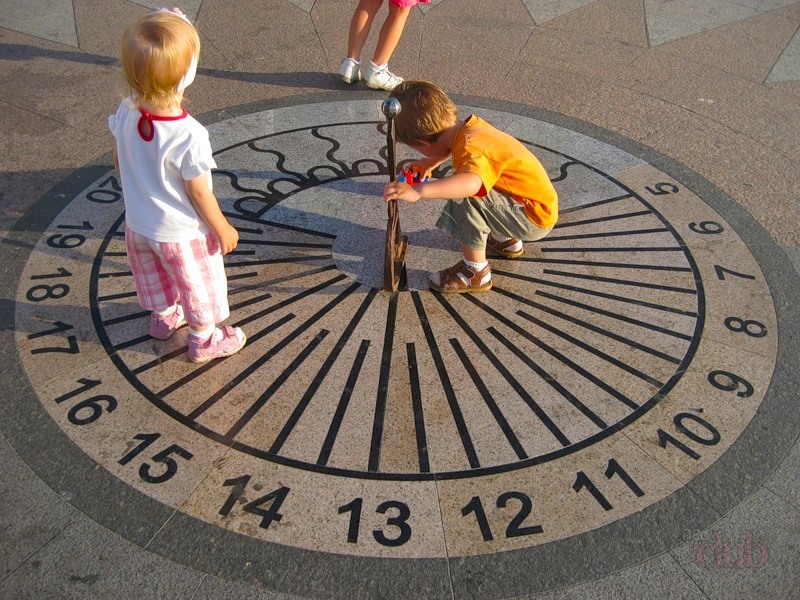 Let your child explore the watch and provide answers to any questions
Let your child explore the watch and provide answers to any questions - Take hourglasses, electronic and clocks with arrows - turn on your favorite music and watch all the changes in this watch. Compare whether 1, 2, 5, 10 minutes passed the same way on them
- First time try to do everything on time- Brush your teeth for 3 minutes, dress for 5-10 minutes. So the child will not only learn to understand the clock, but will also be more organized
- If you see that a child does not want to study the clock and does not show any interest in them - do not insist. It is better to wait or choose a fun game form of learning.
Child must learn to understand by the clock and even though at first the training will be difficult - over time, the baby will definitely master the necessary skills and will successfully apply them in practice.
Video: Child and clock
How to teach a child to understand time on a clock with arrows?
Be prepared for the fact that at first the child will be quite difficult comprehend the peculiarities of timing. The simpler and more accessible you will be able to explain to the child the principles of this abstract process, the faster and more efficiently he will learn new knowledge.
Often children do not understand how to distinguish between such a numbering system as hour field from 1 to 12 and minute field, which is divided into 60 minutes.
Before studying time directly, it is necessary to update the child's knowledge of numbers:
- Learn number count- if a child cannot count up to 60, then it will be very difficult for him to understand by the clock
- Multiply by 5- in order for the child to understand the minutes, not counting them by minute marks, it is desirable that he knows how to add and multiply. This knowledge will help you understand that 5, 10, 15 minutes have passed and so on. In addition, in everyday life we rarely use such an account as 7, 13 minutes, etc., but try to round
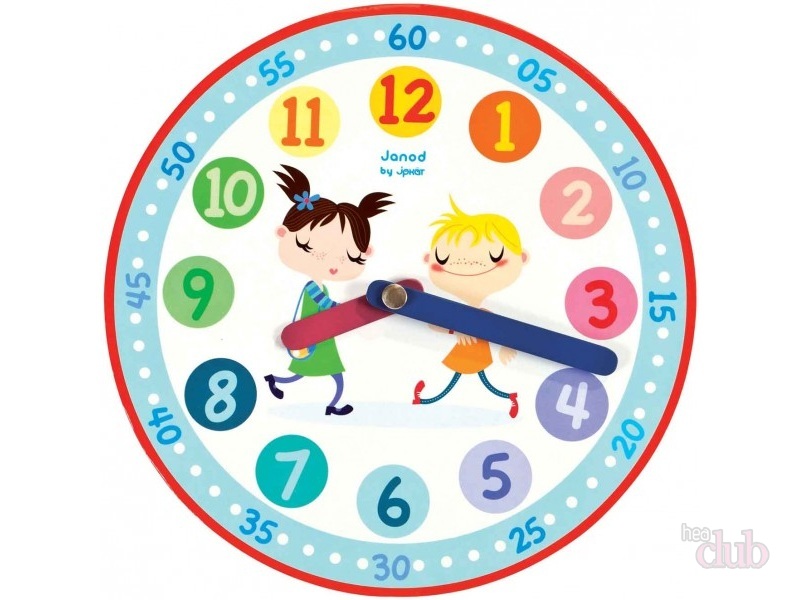 Children have a hard time understanding abstract concepts - illustrate your stories as colorfully as possible
Children have a hard time understanding abstract concepts - illustrate your stories as colorfully as possible - Better teach a child on a big clock, the dial of which does not have a glass coating - so the child will more clearly see the time every minute, and the absence of glass eliminates the possibility of injury, and also allows the child to translate time with his fingers
- in detail explain to your child the difference between a big and a small arrow- first study the time together, then say, let the baby name the time himself, and you will slowly move the hands to the right hours and minutes
- Examine the minute hand- look at the movement of the hand in great detail by minutes, also note that when the minute hand passes the circle, the hour hand will move one digit forward. Be sure to draw the baby's attention to these nuances, if necessary, repeat what was said several times, ask questions that will check the understanding of the child
- draw a clock- in an album or notebook, draw a lot of round, square, triangular clocks and let the child paint them. After that, tell the child the time, and let him draw the arrows on his watch - this fun activity do not leave the child indifferent
- It would be a good idea write digital time next to the painted clock. So the child will learn everything at once - not only the clock, but also repeat the numbers
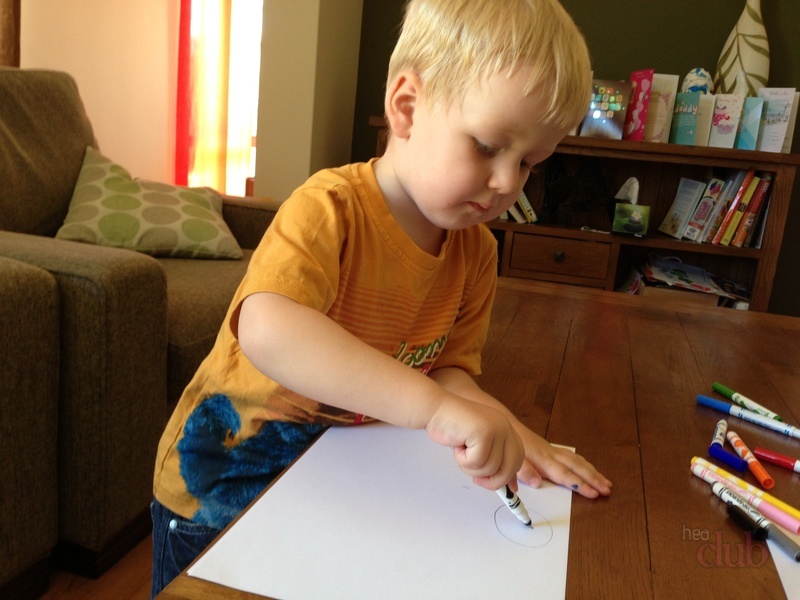 Let the child draw a clock, and you will give the task to depict any time
Let the child draw a clock, and you will give the task to depict any time try do not burden the child too much information at once. Dosed and in a playful way the kid will quickly remember where the arrow is, and what each of them means.
Teach baby time: game
The game- one of the favorite activities of children, which performs an important function - allows you to know the world. In a playful way, you can learn time with your child in an interesting way - this will help him quickly and fun to learn how the clock works.
Exists many options interactive games for various gadgets that help in the study of time - these are programs for the smallest with different tasks, game simulators and even educational cartoons
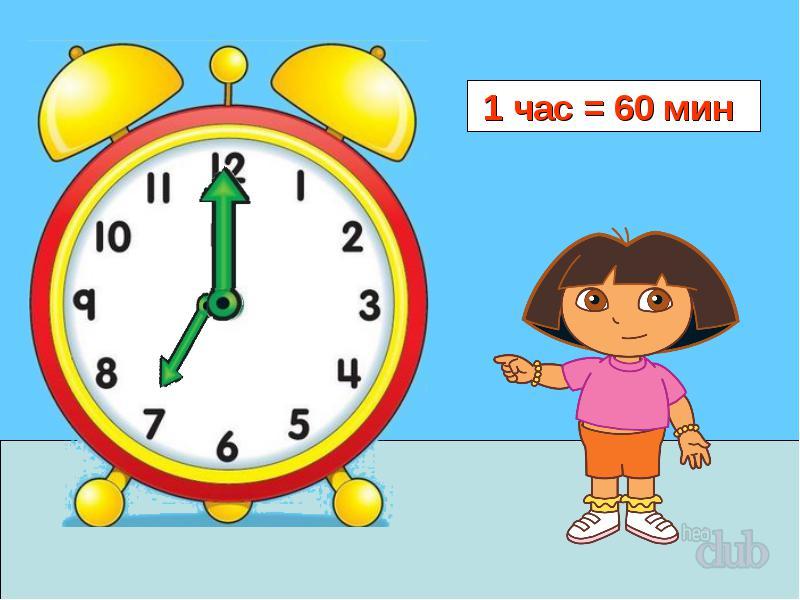 Teach your child to understand the clock in a playful way, and if you see that there is no strong interest in the clock yet, temporarily postpone learning
Teach your child to understand the clock in a playful way, and if you see that there is no strong interest in the clock yet, temporarily postpone learning As an interesting game form of learning time, you can make up a time schedule with your child:
- Use a large poster and colored markers or pencils
- Draw a big clock, and next to the arrows indicate the time with numbers.
- In the intervals between hours, draw the obligatory activities of the child
- For example, you will need to draw such mandatory items as morning awakening, breakfast, daytime sleep, lunch, dinner and night sleep
- Display a poster in a child's room
Between these obligatory points, which the child performs every day, add arbitrary options for the day spent: walking, watching cartoons, going to grandma, shopping and meeting friends. Be sure to tell your child what you need to follow in order to be in time everywhere otherwise, grandma's pies will get cold, and your friends will be upset if you are late.
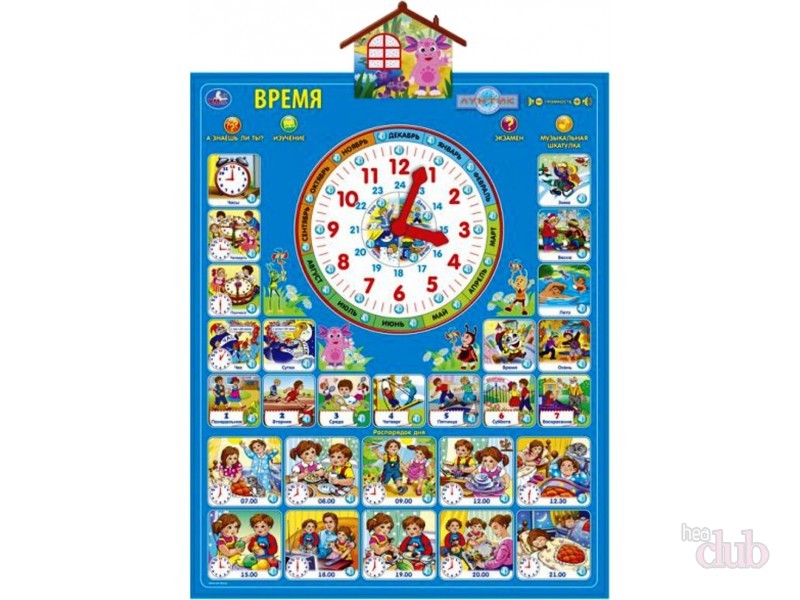 Buy a poster with a clock whose hands can be translated - such a game will quickly teach a child to determine the correct time
Buy a poster with a clock whose hands can be translated - such a game will quickly teach a child to determine the correct time Try to plan everything according to this poster - draw it colorful and fun so that when you wake up, your child’s eyes will surely fall on the wall with a masterpiece of your joint creativity.
- In a playful way, mono teach a child control time: give the child tasks, mark the time and watch them complete
- It is desirable that the execution time game taskwas a little more than required so that the child is always happy that he completes tasks ahead of schedule
- Online games a lot was invented to study the clock, the main thing is to control that the child does not spend too much time at the tablet or computer, since it hurts your eyesight
 Read poems and fairy tales about hours
Read poems and fairy tales about hours - Find a book with funny poems about hours and reading the lines to the child, ask him to look for the time that is spoken of in the verses. This fun activity has both an educational touch and a good way to brighten up the time spent.
- Engage with your child and spend as much time as possible together - in early years the foundations of all elementary knowledge are laid about the world
- And it is mom and dad, as the closest and closest people for the baby, who should help the child to learn previously unknown things and processes.
How to teach a child time by the clock: a simulator?
In a variety of games for learning the clock, you need to choose the best option for your child. It is of great benefit online game for attentiveness, which helps to study the clock - time simulator.
The simplest simulator will help train your memory and study the clock. The principle of the task very simple: in one corner of the screen there is a clock on which, using the mouse, you need to set the correct time, which is indicated on the clock in the opposite corner. For each correct answer, a a certain number of points.
 Simulators will help well to teach the child to watch, but the time in front of the computer should be strictly dosed
Simulators will help well to teach the child to watch, but the time in front of the computer should be strictly dosed - The more completed tasks behind, the more difficult the levels of the game become. At the last levels task clock starts to disappear- first, a clock appears with a set time, then it disappears and a clock is displayed on the screen, which the child will need to “start” himself. Thus, a child who is already a little oriented in time, learn to remember it
- An interesting option for online simulators are games using favorite cartoon characters. For this, a game was invented in which the heroes are in a hurry, on some business, and a window with a clock is shown on top. So the child understands that his favorite doll or spiderman they do everything by the clock
- You can also train your child without using computer games. For example, you can say that tomorrow at a certain time you will go to playground while showing him the time on the clock. Have the child count down different periods days how many hours are left before this anticipated event
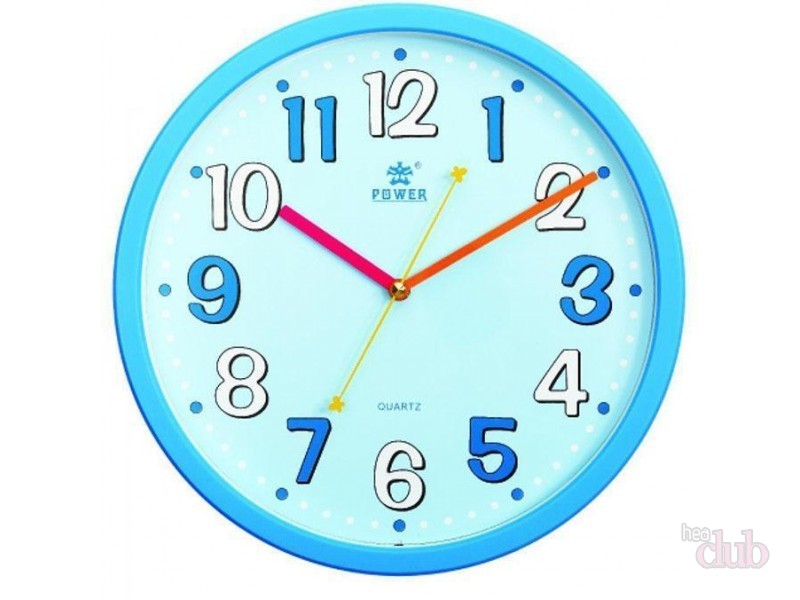 It is better to buy a children's watch for a child - it is safe, and their study is much more interesting for the baby
It is better to buy a children's watch for a child - it is safe, and their study is much more interesting for the baby invent only interesting plans- a walk to the playground or a trip to the zoo. So the child will wait for this event and keep track of time.
Thus, there are many options for familiarizing the time with the child - use interesting game methods, and your baby will definitely remember all the minutes and hours.
How to teach a child the seasons?
- The next step in the child's knowledge of the world will be learning the seasons. When you have already studied the score and time well by the clock, you can proceed to this stage. Don't rush to learn everything at once
- Otherwise, the baby will form porridge in the head from an excess of information, and he will not remember thoroughly either the basic functioning of the clock or the seasons
- If the child has already studied the clock, then he knows that in hour has 60 minutes and there are 24 hours in a day. Now he will have to remember one more numerical value - in a month 30 or 31 days, and in a year 12 months
- It’s very good to start with the child outside and explain to him what time is it now. Look around, explain to him when the grass is green, when it snows, and when the leaves on the trees turn yellow.
 Seasons
Seasons For a long time do not delay learning the seasons- because you won't wait three months to move on to the next season - use a photo album or use digital images.
- tell the child what is remarkable about each season. Convey to him the idea that each season is beautiful and unique in its own way. Let the kid try to tell about what do people do in each period
- Help explain the seasons flip calendars. Be sure to depict the time of year on them so that the child not only listens to your story, but also sees the features of a particular time. visually
- Every day you will tear off a sheet of the calendar with your child and look at the picture where you will see nature - explain to the child through it, what season is it now and cross out another day on the calendar - so the baby will understand when the month ends
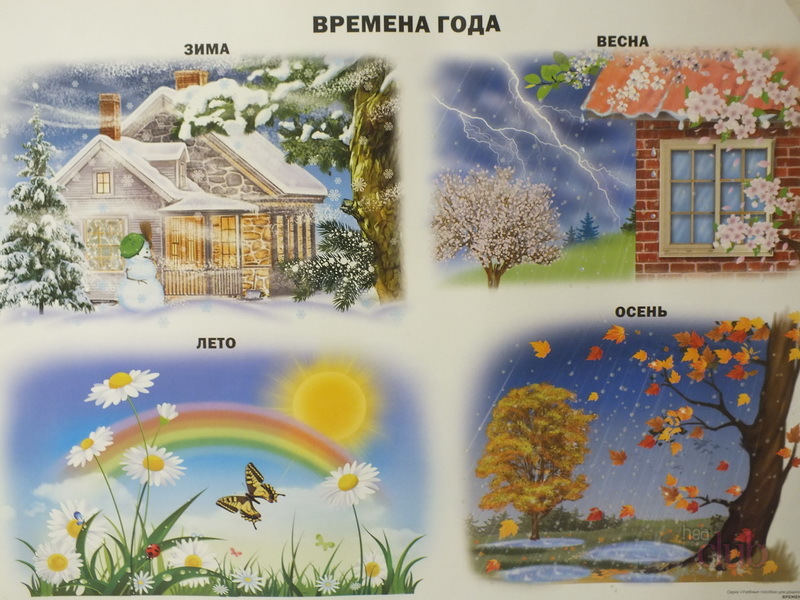 Illustrate your story about the seasons
Illustrate your story about the seasons Think of important dates for the child so that he learns on his own navigate the calendar and seasons. Say that in a month he has a birthday (New Year, Women's Day, Easter) and he will be given a lot of gifts or in the summer you will go to the sea. So the baby will count when the promised days come.
Teach with your child not only the seasons, but also the name of the months. Tell him that there are three months in one season, and only four such seasons. Gradually give him all the information, and do not tell everything in one day.
 Draw the seasons with your child
Draw the seasons with your child - When walking in a playful way, ask the child What day, month and season is it today. And if you see that new information the child has learned, then start learning with him the following
- If you do not try to tell your child about everything at once, then over time with regular repetition, Your baby will already understand with might and main not only by the clock, but will also tell you the name all days of the week and months
- The main thing is to understand that a child's brain is not a computer, do not rush to study something by overloading the baby with information - everything must be done gradually and on time, reinforcing and repeating the studied material
Video: Learning time by the clock with Luntik
